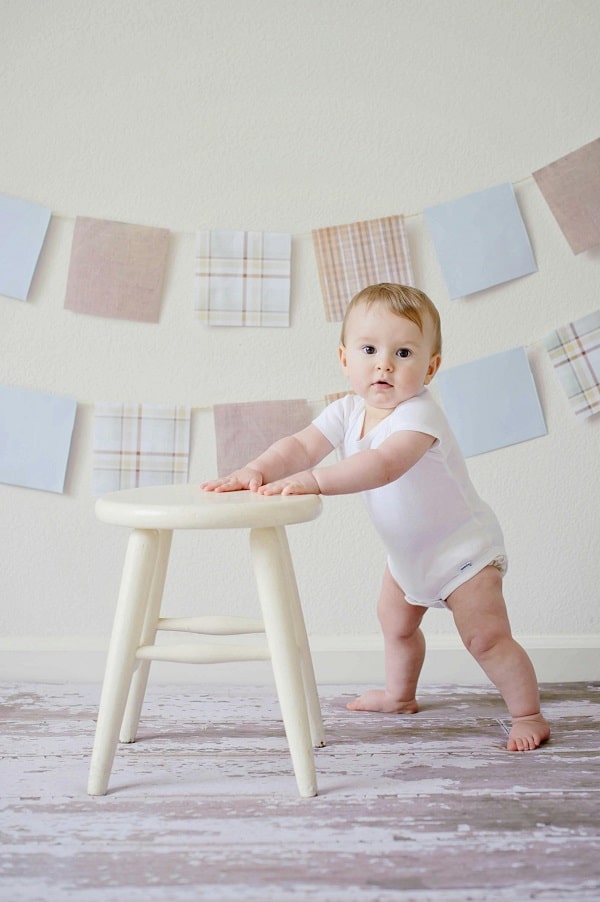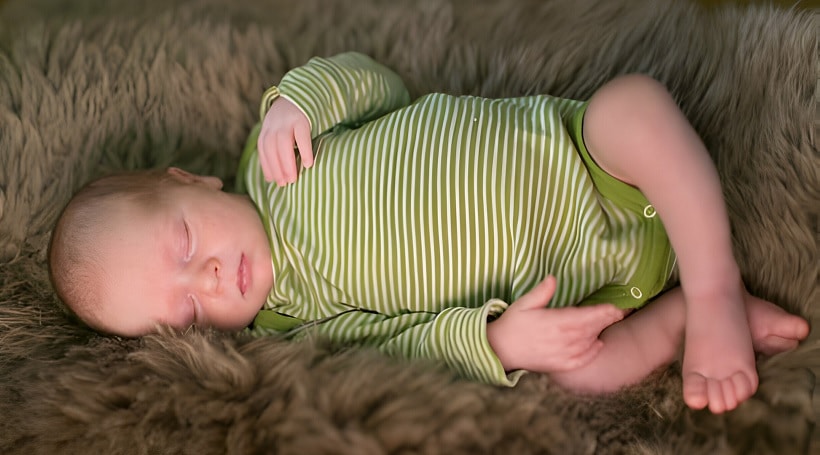Last Updated on January 1, 2025
For baby’s sleepwear, choose a lightweight, breathable onesie for warmer nights, and a snug, long-sleeve onesie with footed pajamas for cooler conditions. Opt for natural fibers like cotton for comfort. Adjust layers according to room temperature, ensuring the baby is neither too hot nor too cold for safe, comfortable sleep.
Deciding what your baby should wear to sleep is more than a matter of fashion; it’s about safety and comfort, ensuring they get the best possible rest. The question of the right sleepwear for babies combines understanding the ambient temperature of the room, the season, and the materials best suited for a baby’s sensitive skin. This comprehensive guide will walk you through the considerations and recommendations for dressing your baby for bedtime, ensuring they are neither too hot nor too cold.

Importance of Temperature Regulation for Babies
Babies, especially newborns, have a hard time regulating their body temperature. This makes it crucial for parents to create a sleep environment that keeps the baby comfortable and safe. Overheating has been linked to sudden infant death syndrome (SIDS), so maintaining a moderate temperature is key. The ideal room temperature for a baby to sleep is generally considered to be between 68°F and 72°F (20°C to 22°C).
Read More – At What Age Is It Selfish To Have A Baby
Seasonal Dressing for Sleep
Summer
In warmer months, the key is to keep your baby cool and prevent overheating. A lightweight, breathable onesie or a sleep sack made of cotton is often sufficient. If the room is particularly hot, even just a diaper and a single layer of muslin, or a light sleep sack may be appropriate. Always feel the back of your baby’s neck or their tummy to check if they’re sweating or feeling too hot.
Winter
During colder months, your focus should shift to keeping your baby warm without overheating. A long-sleeve onesie with footed pajamas or a heavier sleep sack (sometimes fleece-lined for very cold environments) can be ideal. Layers are useful because they can be easily added or removed based on the baby’s temperature. A good rule of thumb is to dress your baby in one more layer than what an adult would comfortably wear in the same environment.
Fabric Choices
The material of your baby’s sleepwear is just as important as the type of clothing. Natural fibers like cotton, bamboo, or merino wool are excellent choices because they’re breathable, soft, and regulate temperature well. These fabrics reduce the risk of overheating and wick away moisture, keeping your baby dry and comfortable.
Safety Considerations
When choosing sleepwear, safety should always come first. Avoid clothes with loose ribbons, strings, or anything that could pose a strangulation risk. Also, steer clear of items with small buttons or decorations that could be choking hazards. The sleepwear should fit well – not too tight, but snug enough that there is no excess fabric that could cover your baby’s face.
Swaddling
For newborns, swaddling can provide a sense of security and warmth. However, it’s crucial to swaddle properly. The swaddle should not be too tight, allowing for hip movement, and should be stopped once the baby shows signs of rolling over to prevent suffocation risks.
Read More – How To Clean A Baby Tongue At Different Stages?
Using Sleep Sacks
Sleep sacks, or wearable blankets, are a safe alternative to traditional blankets, which can cover a baby’s face during sleep and increase the risk of SIDS. Sleep sacks come in various thicknesses for different temperatures and allow for freedom of movement while keeping the baby warm.
Recognizing Overheating
Knowing the signs of an overheated baby is vital. These can include sweating, damp hair, flushed cheeks, heat rash, or rapid breathing. If you notice any of these signs, remove a layer of clothing and check again after a few minutes.

Read More – Why Babies Sleep With Their Butt In The Air?
FAQs
What Should Baby Wear To Sleep?
Babies should wear season-appropriate, breathable clothing to sleep. In summer, a lightweight onesie; in winter, a warmer-footed pajama or sleep sack. Choose natural fabrics like cotton for comfort and adjust layers to ensure they’re neither too hot nor too cold.
What should a baby wear to bed at night?
At night, dress your baby in a snug onesie and a sleep sack suitable for the room’s temperature. Opt for a lightweight version for warm nights and a thicker, perhaps fleece-lined, for cold temperatures. Always prioritize breathability and comfort to promote safe sleep.
What is the best thing for a baby to wear to sleep?
The best sleepwear for a baby is a simple, snug-fitting onesie made of a breathable fabric like cotton, accompanied by a suitable sleep sack for the temperature. This combination promotes comfort, safety, and a good night’s sleep, adjusting layers according to seasonal changes.
What should a baby not wear to bed?
Babies should not wear loose, bulky clothing or have loose blankets, pillows, or toys in their beds, as these can increase the risk of SIDS. Avoid sleepwear with strings, ribbons, or small detachable parts that pose choking or strangulation hazards.
How should I dress my baby in 26 degrees at night?
At 26 degrees Celsius, dress your baby in a light, breathable onesie or just a diaper if it’s particularly warm. Consider a thin, breathable sleep sack if additional warmth is needed. Ensure the baby isn’t overheating by checking their neck or tummy for sweat.
Can my baby sleep in just a diaper?
In very hot conditions, yes, especially if the room is well-ventilated and the baby is monitored for temperature comfort.
How do I know if my baby is cold at night?
Babies usually keep their hands and feet cooler than the rest of their body, so check their chest or back for an accurate gauge. If the skin feels cool to the touch, add another layer.
What about hats and socks?
Hats are generally not recommended for sleep due to overheating risks. Socks, or footed pajamas, are sufficient to keep your baby’s feet warm without needing additional covers.
Conclusion
Dressing your baby for sleep is all about balancing warmth and safety. By choosing the right materials, considering the season, and being mindful of overheating signs, you can ensure your baby has a safe, comfortable night’s sleep. Remember, every baby is different, so it’s essential to continuously monitor and adjust based on your baby’s needs. With these guidelines, you can create a cozy, secure sleeping environment for your little one, promoting restful nights for both baby and parents alike.

